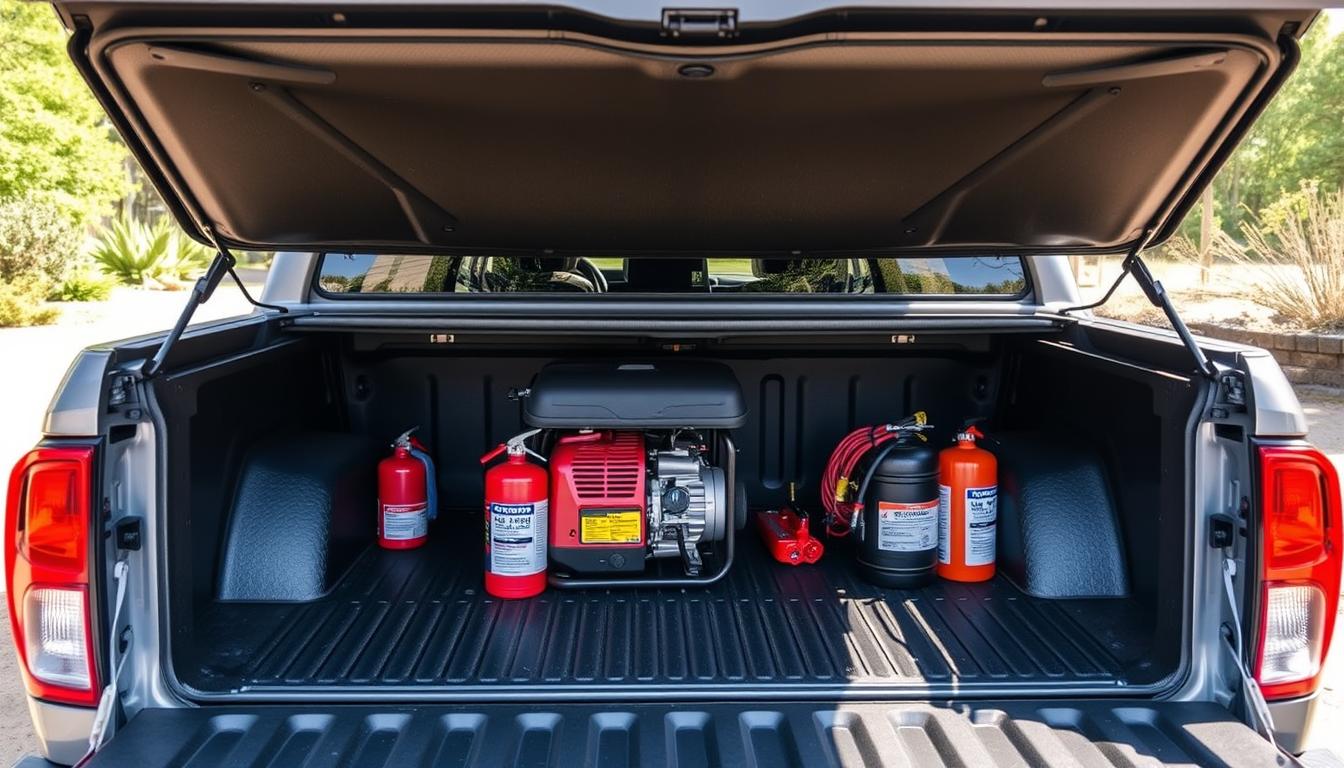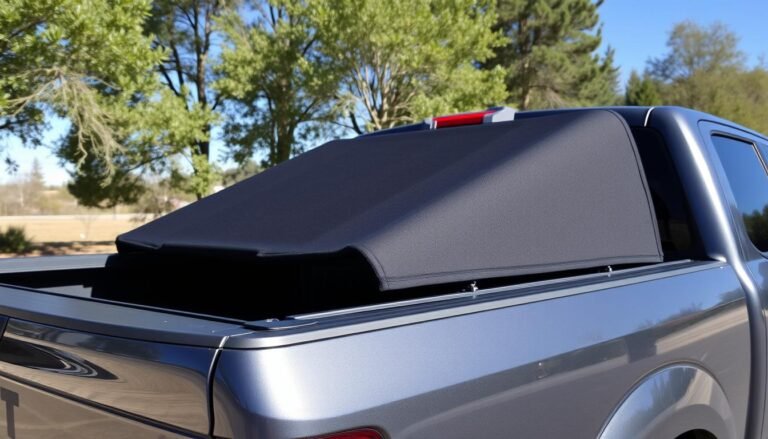Running Generators Under Tonneau Covers: Safety Tips
Using a generator under a tonneau cover needs careful attention to safety. It’s because of the dangers of carbon monoxide and fire risks. Make sure it has enough air and follow safe storage and operation tips. We’ll look at how to place it right, keep it ventilated, and protect the environment.
Generators use propane, gasoline, or diesel fuels. These fuels can be risky. It’s important to have the right amount of fuel for your generator.
When moving a generator, it’s best to keep it upright. Use bungee cords or ties to hold it in place. Don’t put heavy things on it when moving. Always check that the fuel cap and vents are tight to avoid leaks. You might need a kit for spills that includes gloves and absorbent materials.
Don’t move your generator in bad weather, like high winds or heavy rain. It’s smart to label your generator with its details in case it gets lost or stolen. If it’s too heavy, get help from a friend or a professional.
Check out this resource for more tips on managing your outdoor gear.
Can You Run a Generator Under a Tonneau Cover?
Wondering if you can run a generator under a tonneau cover? You need to weigh the benefits and risks first. This idea is popular among vehicle owners for its convenience and security. But it requires careful thought due to safety concerns.
Risks and Hazards
Running a generator under a tonneau cover comes with risks. Main issues include poor ventilation and the danger of carbon monoxide. Online forums are full of warnings about using generators in tight spaces. Not enough air flow can lead to dangerous carbon monoxide levels.
Another concern is overheating, which could cause fires. Both situations are serious and could harm those near the vehicle.
Manufacturer Recommendations
It’s important to follow what the generator’s maker suggests. They often talk about needing good air flow. They might recommend changes to help your generator work safely under a cover. This could mean adding vents or making sure you can reach the gas cap easily.
Listening to these tips helps keep you safe from theft, noise, and bad weather.
Real-World Examples
People have found different ways to safely use generators under tonneau covers. Some share how they’ve modified their trucks for better ventilation and to keep the generator secure. Even though these fixes can help, always check the manufacturer’s advice and expert tips.
Following advice from others, like the suggestions here, can reduce risks. It makes using a generator under a cover safer and more secure.
Importance of Proper Ventilation When Operating Generators
When using generators in confined areas, such as truck beds, ensuring good ventilation is key. If not well-ventilated, serious problems like carbon monoxide poisoning and fire risks can occur. This gas is invisible, has no smell, and can gather at the ground, becoming very dangerous.
Truck Bed Generator Ventilation
Keeping generators well-ventilated in truck beds is very important for safety. A generator that’s not ventilated right under a tonneau cover might get too hot. This heat can damage things around it, including burning tires, which may cause fires.
It’s vital to place generators in spots where air can move freely in the truck bed. Also, when carrying portable generators, they need to be tied down properly. This keeps them from shifting during travel and avoids potential mishaps.
Generator Exhaust Fumes and Safety
Exhaust fumes from generators need careful consideration, especially under tonneau covers. These fumes can fill confined areas quickly, leading to dangerous carbon monoxide levels. Sadly, there have been deaths due to poor ventilation, with people being overcome by gas while asleep.
To keep everyone safe, it’s smart to run generators where there’s plenty of air or think about installing a whole-home generator. Also, keeping fuel tanks secure and limiting how much gas you carry in vehicles can help reduce the chance of fires.
Choosing the Right Tonneau Cover for Generator Use
When you set up a generator in your pickup, it’s vital to choose the right tonneau cover. Factors like design, material, and weather resistance need to be looked at. They help make sure your generator works well and stays protected.
Design and Material Considerations
The design and material of a tonneau cover are key for using with a generator. Materials like aluminum and fiberglass are strong. They can support heavy generators, like the 130 lbs Honda EU3000is. Some covers are made for carrying portable generators, ensuring they have enough air and don’t overheat. For lighter generators, like the Wen 2350 watt that’s about 46 pounds, custom features like wheels help a lot.
Weather Resistance
Choosing a weather-resistant tonneau cover is important for using a generator in your truck. You need a cover that can handle rain and snow. This stops your generator from getting wet, which can cause it to break or create safety issues. Good covers have water-tight seals and are strongly built to avoid these problems.
Ventilation Features
Ventilation is crucial for safely using a generator under a tonneau cover. You need to avoid exhaust fumes building up and the generator overheating. A good generator safety tonneau cover will have vents to keep air moving. This stops dangerous gases from gathering.
| Feature | Standard Tonneau Cover | Generator-Specific Tonneau Cover |
|---|---|---|
| Material | Vinyl or Soft Fabric | Aluminum/Fiberglass |
| Weather Resistance | Moderate | High |
| Ventilation | Minimal | Built-in Vents |
| Design Compatibility | General Use | Supports Generator Use |
Picking the right tonneau cover is essential for your generator’s safety and performance. The right cover keeps your gear safe and works better for longer.
Securing Your Generator to Prevent Theft
Generator theft is common because they have high market value and are easy to sell. It’s key to take steps to protect your valuable generator. This means using a strong lock and hiding it well.
- Use a heavy bicycle cable lock to tie the generator to your vehicle’s rear bumper, like some RV owners do.
- A motorbike cable lock, logging chain, and tough padlock can offer better security.
- Secure the generator with a steel cable lock inside your truck bed. Make sure the tailgate and cover are locked too.
- Wrap a Python Cable Lock around the generator and attach it to a solid structure like the bumper.
- For minimal protection, thread a simple cable lock through the handle and attach it to the stairs.
Know that skilled thieves can quickly cut through most locks or cables. So, using more than one security method is smarter.
Here’s how different security methods stack up for securing generators:
| Security Method | Measurement of Effectiveness |
|---|---|
| Motorbike cable lock with logging chain and high-quality padlock | High |
| Heavy bicycle cable lock secured to the bumper | Moderate |
| Steel cable lock in truck bed with locked tailgate and topper | High |
| Python Cable Lock secured to the bumper | Moderate |
| Basic cable lock through handle secured to stairs | Low |
Consider using several smaller generators instead of one large one. Or keep the generator in a locked place when it’s not in use. These tips help make your generator less attractive to thieves.
Managing Generator Noise: Tips and Best Practices
Reducing generator noise is important in crowded places like campgrounds. To keep peace, it helps to know how to lower sound levels. Learning different methods and using the right tools can make a big difference.
Noise Reduction Covers
Using noise reduction generator covers helps lessen the noise. These covers wrap around the generator. They cut down sound but let air in. Honda and Yamaha make covers for models like the Honda EU2000i. This model is quiet and easy to use, which 25% of campers prefer.
Placement and Positioning
Where you put the generator can also help with noise. Keep it far from where people are or under vehicles, following safety rules. This way, noise goes away from everyone. Some even build special compartments or place the generator on a truck’s rack to keep it quiet.
Remember, safety comes first with noise control. Make sure there’s enough air getting to the generator and use CO detectors. Many campers point out the importance of this, especially when running appliances like air conditioners. Switching between generators and solar power can also cut down on noise, making camping nicer for everyone.
By covering your generator and placing it wisely, you can enjoy a quieter camping trip. This makes things better for you and others around you.
Dry Camping with a Generator Under a Tonneau Cover
Dry camping, or boondocking, is getting more popular with outdoor fans. They love the adventure of being off-grid. To power your campsite, a reliable generator is key. But, some campers want to run their generator under a tonneau cover for extra protection and security. This idea has its hurdles, though.
To use a generator under a tonneau cover, think about a few important things. Your generator must have good airflow. This prevents overheating and stops carbon monoxide from building up. You should pick a tonneau cover that is made to let air move freely.
The type of tonneau cover you choose matters a lot. Brands like BakFlip and Undercover UltraFlex are known for their tough, smart designs. They fit different needs, like working with hitch setups and keeping out the weather. For tips on picking the best cover, check this out.
Running a generator under a tonneau cover means you must follow certain rules. This reduces harm to the environment and keeps you as a respectful camper. Also, it’s important to protect your gear from theft. Use strong locks and tie-downs to keep your generator safe in your truck bed.
Looking at what other campers do can help you decide. Many have talked about the good and bad of using a tonneau cover with a generator. You can find useful tips in online forums. This can help you see what might work for you.
Using a generator under a tonneau cover makes things convenient but needs careful planning. As you head into nature, remember to follow best practices. Use the resources you have to make your off-grid time better.
Safety Measures for Running Portable Generators in Pickup Truck Beds
It’s crucial to follow safety steps when using generators in truck beds. The first step is to place the generator well. This stops harmful gases from gathering nearby. Point the exhaust away and make sure air can flow well.
Choosing the right cover is vital for the generator in your truck bed. The cover must protect it and allow air flow. Use strong materials like aluminum or special ventilated covers. Also, keep the generator far from where people live to avoid carbon monoxide risk.
Regular checks on your generator are a must. Look for any damage or signs of animals that could harm it. A regular inspection keeps your generator working well, preventing breakdowns and extending its life.
By following these safety tips, you keep your generator running smoothly and safely in your truck bed. These steps not only keep you safe but they also make using your generator better. Whether you’re working, camping, or needing power elsewhere, these tips help.

Hey there, I’m Alex Hanson and I’m passionate about all things covers! Whether you’re looking for a car seat cover to protect your vehicle or an oven cover to keep your kitchen clean, I’m here to help. With years of experience in the industry, I have plenty of knowledge and insights to share with my readers. So, if you care about protecting your belongings and making them look their best, you’re encouraged to read my blog as I explore the perfect cover for every need.


